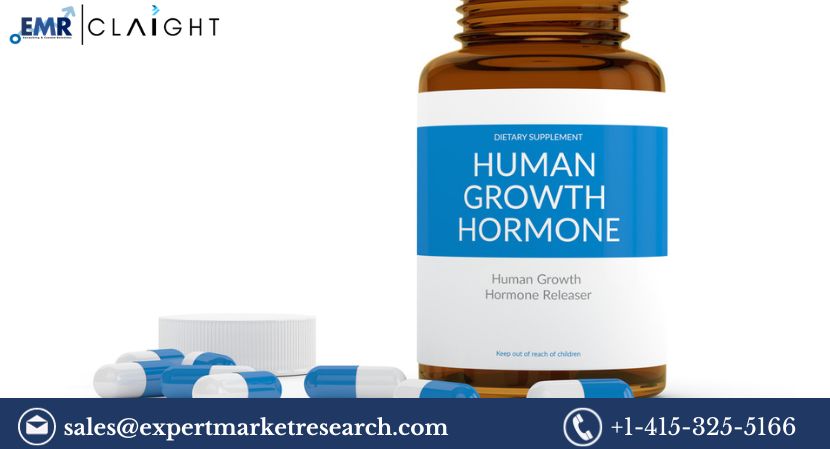Introduction to Human Growth Hormone (HGH)
Human Growth Hormone (HGH), also known as somatotropin, is a crucial peptide hormone produced by the pituitary gland. It plays a vital role in growth, cell repair, and metabolism. HGH is essential for normal physical growth in children and helps maintain muscle and bone mass in adults. Its therapeutic use has expanded beyond growth disorders to include treatments for various conditions such as muscle wasting and short stature.
Market Overview
In 2023, the global HGH market was valued at approximately USD 5.64 billion. This valuation reflects the growing recognition of HGH’s importance in treating deficiencies and related conditions. The market’s trajectory has been influenced by advances in biotechnology and increasing demand for HGH therapies. The market is expected to grow at a robust compound annual growth rate (CAGR) of 8.5% from 2024 to 2032, reaching an estimated USD 11.75 billion by 2032. This growth is fueled by rising awareness, technological advancements, and the increasing prevalence of HGH-related disorders.
Market Dynamics
Drivers of Market Growth
Several factors contribute to the expansion of the HGH market:
- Rising Incidence of HGH Deficiency: There has been a noticeable increase in the number of diagnosed cases of HGH deficiency due to better diagnostic techniques and heightened awareness among healthcare professionals and the public. HGH deficiency can result from various conditions, including pituitary gland disorders, which necessitate medical intervention.
- Increasing Awareness and Diagnosis: Enhanced awareness about HGH-related disorders has led to more diagnoses. Medical advancements in diagnostic tools and increased patient education have played a significant role in identifying individuals who require HGH therapy.
- Advances in HGH Therapies and Technology: The development of recombinant HGH and improvements in delivery mechanisms have made HGH treatments more effective and accessible. Innovations such as needle-free delivery systems and extended-release formulations have contributed to market growth.
Restraints and Challenges
Despite the positive outlook, several challenges could hinder market growth:
- High Cost of HGH Treatments: HGH therapies can be expensive, which may limit access for some patients. The high cost is a barrier to market expansion, particularly in developing regions where healthcare budgets are constrained.
- Regulatory and Approval Hurdles: HGH treatments are subject to stringent regulatory requirements. The lengthy approval processes and the need for extensive clinical trials can delay the availability of new products and impact market growth.
- Potential Side Effects and Safety Concerns: Some HGH treatments may have side effects, such as joint pain or insulin resistance. These concerns can affect patient adherence to therapy and may impact market acceptance.
Opportunities
The HGH market also presents several opportunities:
- Emerging Markets: Growing healthcare infrastructure in emerging economies provides significant growth opportunities. Countries in Asia-Pacific and Latin America are witnessing improvements in healthcare access, which could drive demand for HGH treatments.
- Innovations in HGH Delivery Methods: Ongoing research into new delivery methods, such as oral HGH formulations or advanced injectors, could enhance patient convenience and adherence, further boosting market growth.
- Potential for New Therapeutic Applications: Beyond traditional uses, HGH is being explored for new therapeutic applications, including anti-aging and athletic performance enhancement, which could open new revenue streams for market players.
Get a Free Sample Report with Table of Contents
Market Segmentation
By Product Type
- Recombinant HGH: Recombinant HGH, produced through genetic engineering, is the most common form used in therapy. It is designed to mimic natural HGH and is used to treat various conditions such as growth hormone deficiency and short stature.
- Biosimilar HGH: Biosimilars are highly similar to original HGH products but are usually more affordable. The introduction of biosimilars has increased market competition and provided more options for patients and healthcare providers.
By Application
- Pediatric Growth Disorders: HGH is widely used to treat children with growth disorders, including idiopathic short stature and growth hormone deficiency. This segment remains a significant driver of market growth due to the prevalence of these conditions.
- Adult Growth Hormone Deficiency: Adult HGH deficiency can result from pituitary disorders or aging. Treatments for adults focus on improving quality of life and managing symptoms related to hormone imbalances.
- Other Applications: HGH is also used in other areas, such as for muscle wasting conditions or in anti-aging treatments, although these applications are less common compared to pediatric and adult growth disorders.
By End-User
- Hospitals: Hospitals are major users of HGH treatments due to their comprehensive facilities and access to specialized medical professionals. Hospital-based treatments are often used for severe cases requiring intensive care.
- Clinics: Clinics, including endocrinology and pediatric practices, provide HGH treatments on an outpatient basis. This segment is growing as more specialized clinics offer hormone therapies.
- Home Care Settings: With advancements in delivery methods, HGH treatments are increasingly administered in home settings, offering convenience and reducing the need for frequent hospital visits.
Regional Analysis
North America
- Market Trends and Growth Drivers: North America, particularly the United States, holds a significant share of the global HGH market. The high prevalence of growth disorders, advanced healthcare infrastructure, and significant investments in research and development contribute to the region’s dominance.
- Major Players and Their Strategies: Key players in North America include Eli Lilly and Company and Novo Nordisk AS. These companies focus on expanding their product portfolios and investing in innovative therapies to maintain their market position.
Europe
- Market Dynamics and Growth Potential: Europe presents a mature market with steady growth. The presence of strong healthcare systems and increasing awareness of HGH therapies drive market demand. The market is also supported by various regional health policies and initiatives.
- Key Countries Contributing to the Market: Major contributors include Germany, France, and the United Kingdom. These countries have well-established healthcare infrastructures and are significant players in HGH research and development.
Asia-Pacific
- Emerging Market Trends: The Asia-Pacific region is experiencing rapid growth due to increasing healthcare investments and rising awareness of HGH treatments. Countries such as China and India are witnessing expanding healthcare access and growing demand for HGH therapies.
- Opportunities and Challenges in the Region: Opportunities include a large patient population and improving healthcare infrastructure. Challenges include regulatory hurdles and variations in healthcare access across different countries.
Rest of the World
- Market Overview in Latin America, the Middle East, and Africa: These regions are developing markets with varying levels of growth. Latin America is seeing increased healthcare investments, while the Middle East and Africa are slowly expanding their HGH markets due to improving healthcare systems and rising health awareness.
Competitive Landscape
Key Players in the Market
- AnkeBio Co. Ltd: AnkeBio is a key player known for its focus on HGH production and innovation. The company is involved in developing both recombinant and biosimilar HGH products.
- Eli Lilly and Company: Eli Lilly is a leading pharmaceutical company with a strong presence in the HGH market. The company offers a range of HGH products and is actively involved in research and development.
- Ferring BV: Ferring is renowned for its contributions to hormone therapy, including HGH. The company focuses on developing innovative treatments and expanding its global footprint.
- Novo Nordisk AS: Novo Nordisk is a major player in the HGH market, known for its comprehensive range of HGH products and commitment to advancing hormone therapy through research and development.
Market Share Analysis
- Key Strategies Employed by Major Players: Leading companies employ strategies such as mergers and acquisitions, strategic partnerships, and extensive research and development to maintain their market position. They also focus on expanding their product portfolios and entering new markets.
- Recent Developments and Product Launches: The market is characterized by continuous innovation, with companies regularly launching new products and improving existing therapies to meet evolving patient needs and preferences.
Strategic Initiatives
- Partnerships, Mergers, and Acquisitions: Collaborations between companies and acquisitions of smaller firms are common strategies to enhance market reach and technological capabilities. These initiatives help companies access new markets and technologies.
- R&D Investments and Technological Advancements: Investment in research and development is crucial for staying competitive. Companies are focusing on developing advanced delivery systems, improving drug efficacy, and exploring new therapeutic applications to drive market growth.
Our Best Selling Reports




